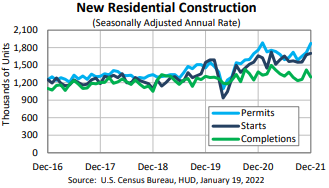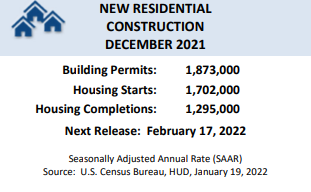 A month-over-month jump in new multifamily construction drove the overall rate of housing starts higher in December, despite a dip in the pace of single-family starts.
A month-over-month jump in new multifamily construction drove the overall rate of housing starts higher in December, despite a dip in the pace of single-family starts.
December multifamily starts surged 13.7% to 524,000, while single-family housing starts declined 2.3% from November’s revised estimate to 1,172,000, the U.S. Census Bureau and the U.S. Department of Housing and Urban Development said in a press release.
Altogether, the combined construction pace of single-family homes and buildings with five or more units was up 1.4% month over month, at 1,702,000 units. Starts were up 2.5% compared to a year ago.
Year over year, multifamily starts ballooned 56%, while single-family starts fell 10.9%.
 “Despite the supply-side headwinds and affordability challenges, strong millennial demand and lean existing-home inventory is supportive of new construction,” First American deputy chief economist Odeta Kushi said in a press release. “Builders can’t close the gap between supply and demand overnight, but they are trying, even in the face of historic challenges.”
“Despite the supply-side headwinds and affordability challenges, strong millennial demand and lean existing-home inventory is supportive of new construction,” First American deputy chief economist Odeta Kushi said in a press release. “Builders can’t close the gap between supply and demand overnight, but they are trying, even in the face of historic challenges.”
The seasonally adjusted annual rate for privately owned housing units authorized by building permits was at 1,873,000 in December, up 9.1% from November and 6.5% compared to a year earlier.
Privately owned housing completions hit an annual rate of 1,295,000 in December, down 8.7% from November and 6.6% from a year earlier.
By region, single-family new construction varied across the U.S. On a month-over-month basis, it jumped 50.8% to 199,000 in the Midwest and 11.1% to 70,000 in the Northeast, and it fell 14.6% to 245,000 in the West and 13.8% in the South.
“Home pricing has soared to record levels in 2021, though at the same time, the rental market has seen unprecedented rent growth, so home seekers are left with limited affordable options and may be more willing to accept higher prices,” RCLCO Real Estate Consulting principal Kelly Mangold said. “The strong starts in December, a historically slower month amid the holiday season, reflects market optimism in the residential sector and bodes well for a strong start to 2022.”
